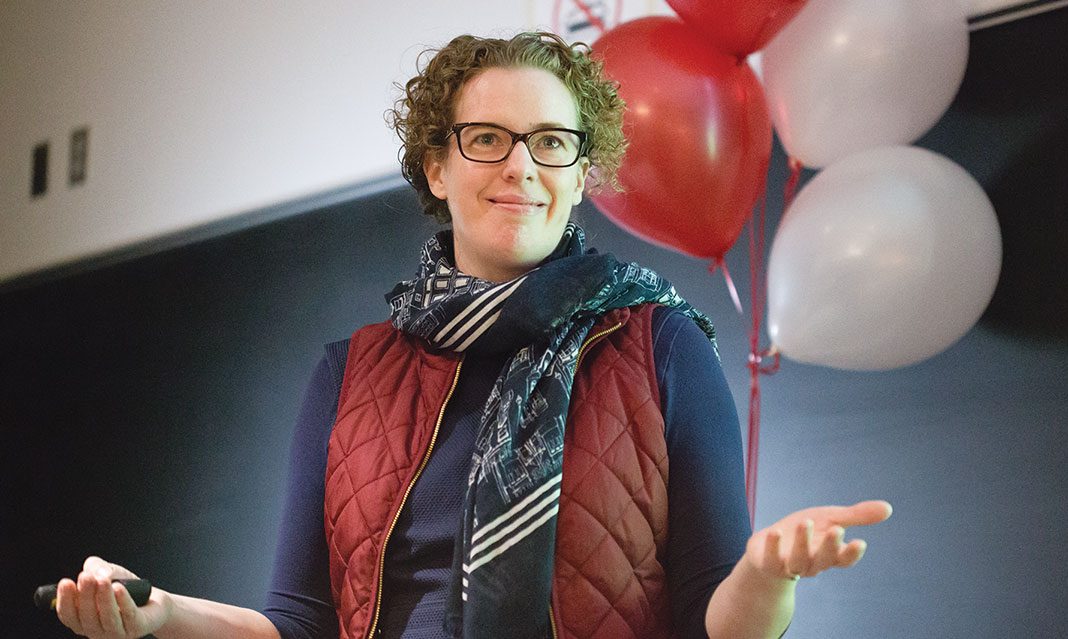This month’s “Lecture me!” event hosted at the Mississauga Central Library by the Experiential Education Office at UTM featured professor Fiona Rawle from the UTM biology department. Rawle also serves as the associate dean, undergraduate. Her research is geared towards science communication and education, as well as engaging students and the public. Based on her research, Rawle discusses the misunderstandings in science news and how to distinguish between real versus fake news.
Fake news, as defined by Rawle, could be a photo, video, or any source of information that is “intentionally made to confuse and misdirect.” According to Rawle, an example of fake news could be some of the stories surrounding Hurricane Irma, where sources were claiming it was the most powerful hurricane in history, which was not the case. As Rawle mentions, various U.S. institutions proceeded to warn the public against sharing these fake news posts as an attempt to tackle this issue.
Another category of fake news is a real photo or video that has been “manipulated for deception,” notes Rawle, such as the manipulation of photos during the most recent U.S presidential election.
Another category of fake news could be communicating information intended for comedy, satire, and entertainment. In this case, the intent is not to manipulate the audience but nevertheless, “People end up being fooled,” says Rawle.
“It’s a continuum. On one end, you have fake news, or false news, and before you get to accurate news, you have sensationalized news where they’re talking about something that’s accurate but they’re using words that often elicit emotions and it’s sensationalized,” explains Rawle. Since this continuum is in the context of science, it is essential to analyze them based on a scale of the quality of science presented, with bad science or pseudoscience at the bottom, and good science at the top of the scale.
Rawle uses the phrase “FALSE CASE” as an acronym for the audience to distinguish between real and fake news. The acronym stands for Feel/Emotion, Author, Language, Source, Exclusive/Secret, Claim, Agenda, Scheme/Conspiracy, and Everything-is-cured.
One of the indicators of bad news, according to Rawle, is if the information elicits a spike in emotion. When the emotions triggered by certain news are too extreme, chances are this news is false. An example of this, as Rawle explains, is a headline claiming, “Every single person that has cancer has a pH that’s too acidic,” which according to her, is clearly intended to trigger certain emotions of fear and paranoia from the reader. Often there are trigger words that are associated with these feelings.
When reading news, as Rawle elaborates, it’s also important to note the use of language and its purpose: “What language is being used? Is it accurate? Is it inflammatory? Is it casual?” These are all questions Rawle suggests we ask ourselves when analyzing science news. The use of words, such as “epic,” is a clear example of flashy language that is rarely used in accurate news headlines.
Another clue to watch out for is the use of chemical words to elicit a fear response. An interesting example Rawle portrays is an article titled “What does DHMO do to your body?,” includes a list of potentially harmful side effects of DHMO. According to this article, DHMO is a harmful chemical. However, when Rawle asked the audience what DHMO stands for, they soon realized that it is dihydrogen monoxide which is the chemical term for water.
As the biology professor emphasizes, it is essential to determine who the author of the news article is and review their credentials to get an idea of the reliability of the information. If you cannot find the author of a specific article, that is likely an indicator of fake news. In addition to the author, the source—for example, online, social media, academic journal—of the information is critical to assess the credibility of the news. Also, if you are reading information that is considered exclusive or secret and you may be the first to know, then chances are you’re reading fake news.
Identifying the claim of a news article is key to understanding the intention of communicating this information. News that is based on conspiracy theories, as Rawle suggests, are generally fake. Most notably, news that advocate a certain cure for cancer and other diseases is not accurate.
In science journalism, as Rawle explains, a new rule is established that “If your article can be summarized as no, then don’t write it.” She continued to add that science articles that pose questions with an obvious “no” answer are generally sensationalized news.
The scientific method is key when reading science news because science must be replicated and these methods act as a recipe for replication. Although science is much more complex than a simple recipe, the scientific method is nevertheless a useful tool for the public to evaluate the science news.
Highlighting the concerns about the link between vaccinations and disease, Rawle explains, “Andrew Wakefield, who published a study in the late 1990s, kicked off this worry about the MMR vaccine being linked to autism.” This MMR (measles, mumps, and rubella) vaccine study is an example of how to identify bad science because the data that was published by Wakefield, only contained 12 patients and showed the behavioral diagnosis, casual agents, and the interval from exposure to symptoms. This was all the data that was presented in the report. As Rawle describes, the issues with Wakefield’s paper include: very little data, too small of a sample size, children were not randomly selected, Wakefield had a conflict of interest, and concluded causation versus correlation, and therefore, Wakefield’s paper is clearly an example of sensationalized news.
Rawle concludes that the challenge is that readers must look at the data when reading science news and not accept the anecdote. Additionally, as Rawle says, “The other challenge is deciphering good science from the bad and deciphering accurate news from inaccurate news.”



